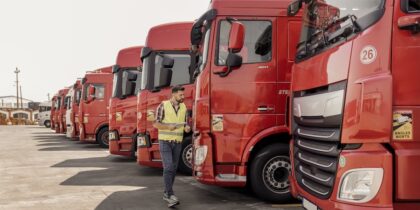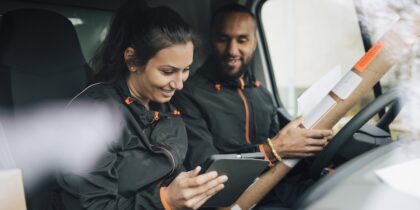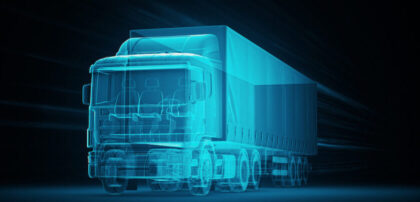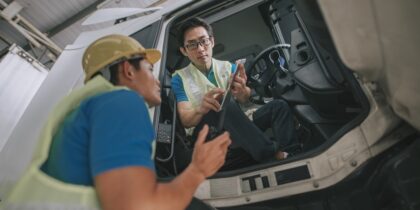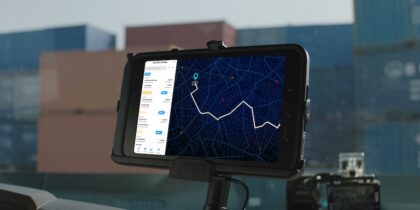Disputed deliveries can lead to back-office complications, delayed receivables and unhappy customers. To improve service and reduce costs, more drivers are carrying smartphones and tablets with digital proof of delivery (POD) apps. The mobile devices communicate with their company’s back office, automatically keeping headquarters informed of items’ delivery status and other vital data.
A comprehensive mobile POD solution streamlines supply chain operations by automating driver tasks — ensuring accurate, on-time and error-free pickups, deliveries and returns. It gives even small companies capabilities that can compete with the more expensive tech deployed by logistics giants.
Drivers can electronically complete tasks while they capture POD documentation, such as electronic signatures, photos and notes, and process exceptions and returns. Mobile devices, including rugged tablets like the Samsung Galaxy Tab Active3 and rugged phones like the Galaxy XCover Pro, can also support other delivery workflows, such as document imaging and barcode scanning with Knox Capture, which transforms a mobile device into an enterprise-grade scanner in a snap.
Date, time and GPS coordinates can also be automatically logged for all arrivals and departures. Thanks to this real-time visibility, the back office has an easier time dealing with disputes that cause payment delays and other problems.
Take the paper out of paperwork
With a mobile platform like the one built by Omnitracs, delivery personnel can ask customers to verify receipt by signing for shipments using their finger instead of a stylus. This lets people sign faster, which increases drivers’ productivity and saves recipients time as well.
“The wholesale distributors love it; they’re able to show their customers they can use advanced technology like the big carriers, and it didn’t cost them a lot,” says Randy Starr, vice president of technology at Omnitracs.
Delivery verification can also include photos, so employees can document where they dropped off a product. For example, if a customer reports they’re missing an expected pallet, you can confirm delivery and help locate the missing shipment.
Digital POD pickup services have also expanded to larger logistics companies. For pickups, the app has to be ready to handle returns from overages, shortages and damage. The app allows drivers to capture data about returns while on the go.
Streamline supply chain operations
The software functionality can be customized to your company’s specific supply chain operations. Some organizations will want to plan and track routes and fuel stops. The software includes dynamic hierarchies that can prioritize different stops, including pickups and deliveries. This enforces the driver’s hours of service rules, driving times and required breaks.
“The platform has a lot of capabilities built into it and can be tailored to a company’s specific needs,” says Starr. “If a company doesn’t do pickups, that functionality won’t be in their version.”
A customized version of the software allows drivers and managers to focus on only the tasks at hand, reducing the complexity of the app and boosting efficiency. The app is cloud-based, so companies don’t have to invest in dedicated IT infrastructure to operate it.
“The beauty of the application is that the information is recorded within the app, communicated through the cloud and delivered straight to the back office and all without any extra work from employees,” says Starr.
Increase fleet efficiencies with in-cab technology
Learn how an ELD implemented on a mobile platform reduces operating costs and improves driver retention. Download Now
Using the cloud eliminates the need for handling paperwork and gives managers and employees ubiquitous access to real-time data. Customers can be immediately notified about pickups and deliveries, by email or text.
This technology supports both connected and disconnected communications, so users can continue to work off the grid, then upload and download information when they regain web access, maintaining seamless integration with back-office systems.
Responsive design supports multiple platforms
The responsive design of the mobile app adjusts the interface for optimum ease of use on any Samsung smartphone or tablet, such as the Samsung Galaxy S21, Galaxy Note20 or Tab Active3.
A user can even access the same information on different devices. For instance, if a delivery driver uses a tablet in the cab for routing and communications, they can seamlessly switch to a phone for tasks outside the cab.
This allows them to double-check a delivery order on their phone from the back of the truck before stacking the appropriate packages on the hand truck. Then, they can tuck their phone into their pocket or holster while moving the product, and once the boxes are at the customer’s door, the driver can use their phone to grab the customer’s signature and take a photo of the delivered package.
By taking the paper out of the paperwork, digital POD streamlines supply chain operations, ensuring correct and on-time pickups, deliveries and returns — which in turn allows shippers and carriers to better serve their customers, improve their productivity, lower their operating costs and increase their margins.
As you strategize a tech upgrade for your supply chain, you can also increase your warehouse efficiency and cut costs with mobile processes, outlined in Samsung’s free guide. Or, discover more mobile transportation solutions, set to dramatically impact this rapidly changing industry.


